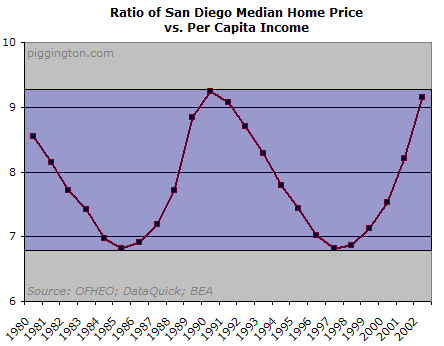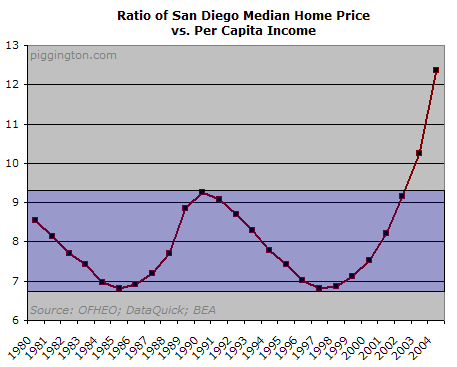If San Diego home prices do not reflect fundamentals, exactly how did they get to such rarified heights, and what keeps them aloft? It’s a fair question, and an important one: understanding how the bubble started will be crucial in identifying how and when the bubble ends. The purpose of this article is to provide a very brief overview of how we got here.
Birth of a Bull Market
Let’s flash all the way to back 1997. The San Diego real estate market was fairly depressed, having weathered several years of adverse conditions: the fallout from the prior housing bubble exacerbated a local recession as the end of the Cold War sent thousands of defense and aerospace workers packing. By this time, as the following graph shows, San Diego homes were as undervalued as they’d been since 1985:

But San Diego’s economy was already undertaking a brisk recovery as the late-90s “Goldilocks Economy” got into full swing. As would be expected, the housing market finally began to recover and head back towards (and eventually beyond) fair value. As home prices steadily rose over the next several years, the negative sentiment towards real estate that was prevalent throughout the mid-90s was gradually replaced with optimism. By 2002, despite the fact that the Roaring 90s were over and the nation had just been through a recession, the home price to income ratio had reached its historical high point again:

Given the relatively high expense of housing and the shakiness of the economy, one might have expected that home prices would begin to moderate at this point and make their way down to the bottom of the valuation channel, as they had typically done in the past. But one would have been mistaken. This time, as the saying goes, was different, and the difference could be described in one word: credit.
The Credit Tsunami
In an attempt to revive the faltering economy in the wake of a stock crash, a recession, and the 9/11 attacks, Alan Greenspan had recently embarked on a rate-slashing frenzy that would not stop until the Federal Funds Rate had gone from 6.5% down to a multi-generational low of 1%. The idea of such low short-term rates is to stimulate economic activity thusly:
- Financial institutions are able to borrow money at the low short-term rates and lend it out at long-term rates, pocketing the “spread” between long and short term rates. This encourages financial institutions to lend as much money as they can, driving down rates across the board.
- The low available rates encourage consumers to borrow in order to keep our consumption-heavy economy moving along.
- Those same low rates encourage businesses to borrow in order to keep business spending and hiring up.
Borrowing was stimulated, to be sure, but not exactly in the intended manner. Businesses, instead of borrowing money to rebuild their workforces, offshored enormous amounts of work and used the savings to clean up their balance sheets. Consumers, on the other hand, borrowed like there was no tomorrow, running up credit cards, getting into previously unimaginable amounts of mortgage debt, and generally taking the national savings rate to an all-time low.
Meanwhile, a new paradigm was emerging in the currency markets that added even more fuel to the borrowing fire. Bear with me for a few paragraphs as I try to explain this rather complex and nuanced topic as briefly as possible.
What was happening was that the export-heavy Asian economies were going to great lengths to keep their currencies low against the dollar, thus keeping their products cheap for Americans to buy. The primary mechanism for this currency intervention was as follows, using Japan as an example: Japan would receive into its banking system US dollars which came from Americans who were buying Japanese products. The Bank of Japan did not want to sell these dollars in exchange for yen, because doing so would add to the supply of dollars for sale and add to the demand for yen, effectively strengthen the yen against the dollar and driving up dollar-denominated prices for Japanese goods. So they kept their money in US dollars by using it to buy US financial assets, primarily Treasuries and other debt instruments, thus avoiding weakening the dollar.
The Asian central banks’ heroic efforts to keep their currencies weak against the dollar, combined with their own incredibly low short-term rates, also encouraged their own private investors to buy US debt instruments. Using Japan as an example, again: a Japanese saver (and there are a lot of them—unlike here in the US, there is a huge cultural prerogative to save money in Asia) would be looking around for a place to invest money. Japanese government bonds would be yielding between 1% and 2%. US Treasuries would be yielding around 4%—not great, but better than Japanese bonds. And due to Japanese central bank’s obvious commitment to keeping their currency weak against the dollar, there was little chance for the private investor to lose money via currency exchange rates. The choice was obvious: buy dollar-denominated bonds.
So we had Asian central banks lending money to Americans (buying a bond, after all, is the same as lending money to the bondholder), we had private Asian investors lending money to Americans, and we had American financial firms borrowing freshly-minted money from the Fed and lending it to other Americans. In short, there was literally more money being lent—and more eagerness to lend it—than the world had ever seen.
Meanwhile, Back at the Ranch…
OK, let’s go back to San Diego circa 2002. Homes had gotten fairly expensive, and normally at this point in the housing cycle the lack of affordability would start to reign in home prices. But San Diego never got there because as home prices marched upwards the credit markets became flooded with ever more money. The resultant lowering of rates and lending standards allowed San Diegans to carry mortgages on homes at ever-higher prices.
Having built up a nice head of steam thus far, San Diego home prices exploded into 2003 and 2004 on the wave of easy credit. The sense of invincibility and optimism was now absolutely ubiquitous, and people’s willingness to take on more risk grew as fast as prices. Lending begot more lending as borrowed money drove home prices ever upwards and lending institutions, emboldened by the rise in the value of their collateral, started to lend more and more freely.

By 2004, home prices were well beyond all rational measures of fair value, but that didn’t matter. No price was too high to pay for the money-making machine that was a San Diego home. The market culminated with an early-2004 bout of panic-buying, featuring the kind of frenzied bidding wars that only take place when the hordes have abandoned their senses.
Things have calmed down a bit since then, due partly to the Fed’s leisurely tightening efforts, partly to the dawning recognition by many San Diegans that we are indeed experiencing a bubble, and to plain old exhaustion, as the market runs out of people willing to buy at these levels. Prices have pretty well flattened out since mid-2004.
And so we wait. One cannot predict exactly how this bubble will play out. But one can adopt the premise that we are indeed in experiencing housing bubble and can use that framework to properly interpret events and market data as they occur. Doing so is one of the primary goals of this website.
